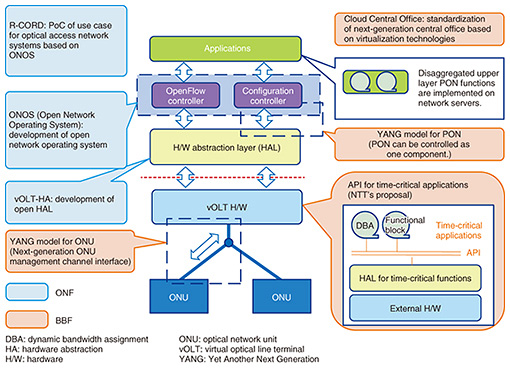 |
|||||||||||||||||||||
|
|
|||||||||||||||||||||
|
Feature Articles: Creating a Flexible and Smart Network as a New Social Infrastructure Vol. 16, No. 6, pp. 41–47, June 2018. https://doi.org/10.53829/ntr201806fa7 Global Collaboration Initiatives Revolutionizing Research and Development of Network TechnologiesAbstractTo transform the network into a new social infrastructure, it is essential that the research and development (R&D) scheme for network systems be revolutionized not only by promoting more tie-ups than ever before with diverse business partners but also by collaborating with global partners in various phases of the R&D process. This article presents examples of these activities focusing on the APAC (Asia-Pacific) Telecom Innovation Initiative (ATII) now in progress and collaborative efforts with carriers and other partners based outside of Japan. Keywords: network R&D, open innovation, global expansion 1. Global collaboration in network research and development (R&D)At the NTT laboratories, we have been working to expand NTT technology globally through standardization activities and other efforts and have therefore formed collaborative tie-ups with carriers and business partners such as vendors outside Japan. Now, with the aim of transforming the network into a new social infrastructure, we plan to form collaborative tie-ups with global partners at various R&D phases driven through open innovation, and to promote more tie-ups than ever before with diverse business partners. These efforts reflect the importance of forming a new ecosystem while revolutionizing the R&D scheme and promoting accelerated R&D. To be more specific, we are beginning to engage with Asia-Pacific (APAC) carriers in addition to carrying out our traditional activities with European and American carriers through standards developing organizations (SDOs). Our approach here is to undertake joint studies from the early stages of R&D on use cases, technology applicability, and common carrier requirements. APAC has high growth potential as a telecommunications market compared with Europe and the United States, and future investment in new technologies and services for the telecommunications infrastructure can be expected. APAC also includes many countries having diverse regional characteristics, and this is expected to lead to the development of new services based on diverse needs in the telecommunications market and information and communication technology (ICT) industry. Collaborating with a variety of players in the APAC region should stimulate innovation in the use of ICT and contribute to the creation and expansion of a productive and affluent society in the APAC region. Our aim here is to use this engagement with APAC as an opportunity to transform the entire global industry. In this article, we introduce the APAC Telecom Innovation Initiative (ATII) now in progress and collaborative efforts with carriers and other partners outside Japan as specific examples of our new approach to network R&D. 2. ATII R&D initiative and global dissemination from the APAC regionIn April 2017, NTT and PT Telkomunikasi Indonesia (Persero) Tbk (hereinafter, TELKOM), Indonesia’s leading telecommunications provider, established ATII as an R&D initiative targeting virtual infrastructure technologies with the aim of improving communication services and creating new network services in the APAC region [1]. The Vietnam Posts and Telecommunications Group (VNPT) joined ATII in September 2017, and at present, the initiative participants are actively working to disseminate information from the APAC region on a global scale (Fig. 1). Joint studies are being conducted in the ATII toward the creation of new network services with a view to 2020 and beyond. Moreover, with the aim of solving common problems in the APAC region, joint technical studies and proofs of concept (PoCs) are being carried out on “Flexible and Smart Network” technologies with a focus on virtual infrastructure technologies. Three work projects (WPs) have so far been launched to conduct joint studies and PoCs.
(1) WP1: High Value-added Network Services We conducted a joint PoC with TELKOM on smart building services applying Data Stream Assist technology [2] at a TELKOM building in Bandung, Indonesia (Fig. 2). From here on, we plan to conduct more studies toward field trials of such services.
(2) WP2: Server Platform Virtualization We conducted a joint PoC based on a virtual customer premises equipment (vCPE) use case. The demonstration involved controlling a TELKOM virtual firewall (vFW) by using NTT virtual machine manager technology [3] via an interconnection between TELKOM (Bandung) and NTT (Tokyo – Kuala Lumpur) test beds (Fig. 3). With the knowledge gained here, we are improving elemental technologies and planning to popularize and expand this scheme by contributing it to open source software (OSS) communities.
(3) WP3: Flexible Access Network Virtualization We conducted a joint study on access network virtualization based on Flexible Access System Architecture (FASA) [4, 5] and undertook the drafting of common specifications by extracting common requirements from use cases brought to the study. We released the results of this study as a white paper and are now promoting standardization activities with TELKOM and other European and American carriers at the Broadband Forum (BBF). At ATII, we plan to make proposals and suggestions to SDOs and industry alliances by pursuing more joint studies and PoCs as we go forward. We also seek to expand this initiative by encouraging the participation of more service providers and partners. 3. Activities regarding access network virtualization (FASA) with an eye to global expansionFASA was proposed in February 2016 by the NTT laboratories as a concept related to the development of future access network technology. We explain the latest activities involving FASA in this section. 3.1 FASA activities to dateThe aim with FASA is to enable end users to access diverse services in a quick and low-cost manner and to enable service providers (the second ‘B’ in the B2B2X (business-to-business-to-X) model) to provide services promptly. To realize the FASA concept, we released a FASA application programming interface (API) in phases as white papers in May 2016 and February 2017, promoting it as a commonly usable API. 3.2 Collaboration with other organizations on access network virtualizationThe Central Office Re-architected as a Datacenter (CORD) project for virtualizing and reconfiguring a telecom carrier’s central office in the same way as a datacenter is being moved forward in the Open Networking Foundation (ONF). In particular, studies on passive optical network (PON) virtualization are being conducted in the R-CORD (Residential CORD) project targeting subscribers (access the network). In this project, we are realizing FASA through verification experiments on use cases based on FASA (Fig. 4).
The BBF, moreover, has launched the standardization of Cloud Central Office corresponding to CORD in ONF, and in terms of access, it is standardizing specifications for architecture targeting software-defined networking (SDN) access nodes and for YANG (Yet Another Next Generation) data modules for use in configuring and managing access network equipment. The abstraction layers of the virtual OLT (optical line terminal) are being investigated to communalize the equipment interface that is dependent on hardware. There are many areas in which these standardization activities overlap with FASA, so we are cooperating with other organizations to reflect FASA requirements and specifications in those areas and accelerate research on FASA. Furthermore, as part of the FASA activities, we have proposed a new standardization project at BBF on the virtualization of time-critical applications such as DBA (dynamic bandwidth assignment) and have commenced related standardization activities [6]. Additionally, as part of our access virtualization efforts in ATII WP3 described above, we are extracting common requirements among APAC carriers and incorporating them into FASA to communalize FASA technology. In short, we aim to globalize FASA and related technologies by studying FASA use cases using OSS, standardizing technologies that reflect FASA requirements, and communalizing FASA technologies among carriers. 4. Joint experiment with Chunghwa Telecom using white-box switchesIn this section, we report on a joint experiment conducted with Chunghwa Telecom of Taiwan in 2017. 4.1 Carrier collaboration with Chunghwa TelecomTelecom carriers have not only sought to lower costs in recent years but have also expressed a growing need to have networks that can respond quickly and flexibly to dramatic increases in traffic and diverse usage scenarios. To this end, it is becoming increasingly important to use globally common and general-purpose technologies and products instead of conventional carrier-dedicated network products. The NTT laboratories have begun collaborating with Chunghwa Telecom on the application of common and general-purpose technologies and products to various areas of a carrier network (network edge, core backbone network, and datacenter network). Activities such as these are helping to form stronger inter-APAC-carrier ties. In this collaboration, a memorandum of understanding on joint research and joint experiments was signed in February 2017, and a joint experiment was successfully conducted at Chunghwa Telecom Laboratories in Taoyuan City, Taiwan, from November 20 to December 1, 2017 [7]. 4.2 Verification of virtual-network configuration and control technologiesThe NTT laboratories have been developing Multi-Service Fabric (MSF) technology as part of their R&D efforts in configuring a network with general-purpose equipment [8]. MSF is technology for configuring a highly reliable network using simple general-purpose equipment while also being an SDN architecture supporting multi-vendor network equipment. This technology was first released as OSS in October 2017 [9]. In this architecture, the MSF controller interacts with upper-level systems using REST (Representational State Transfer) and controls target switches using a configuration and control protocol such as NETCONF (Network Configuration Protocol). Additionally, with the assumed use of a Clos* network topology consisting of switches incorporating a general-purpose data-transfer ASIC (application specific integrated circuit) such as white-box switches, MSF can achieve virtual networks such as a Virtual eXtensible Local Area Network (VXLAN) or layer-3 virtual private network (VPN) using MPLS (Multi-Protocol Label Switching). Chunghwa Telecom, meanwhile, has proposed a uniform control method for multiple SDN architectures using a GUI (graphical user interface) and has developed an orchestrator called Network Adapter with Programmability and Automation (NAPA) that can easily grasp network conditions. NTT and Chunghwa Telecom conducted a joint experiment on linking NAPA and MSF to verify virtual-network configuration and control technologies using an Ethernet VPN VXLAN running on an operating system for white-box switches (Fig. 5). In addition to verifying the interoperability of both companies’ technologies, this joint experiment simulated faults that can occur in carrier network operation in order to verify a level of reliability that ensures service continuity can be provided. For example, the experiment verified that redundancy measures at the time of a fault in the MSF controller and automatic switching of communication paths at the time of a fault in white-box switches were functioning adequately.
NTT and Chunghwa Telecom plan to use the knowledge gained in this joint experiment to conduct more detailed technical studies and tests toward the use of general-purpose products such as white-box switches in commercial services. Moreover, at NTT, we will disseminate these experimental results and the knowledge gained from this collaboration in open communities such as Telecom Infra Project and ONF with the aim of gaining more advocates of this technology on a global basis.
5. Future developmentThe NTT laboratories will continue to collaborate with diverse global partners and promote accelerated R&D for network technologies driven by open innovation with the aim of achieving a network that creates new value for its users. References
|
|||||||||||||||||||||
















